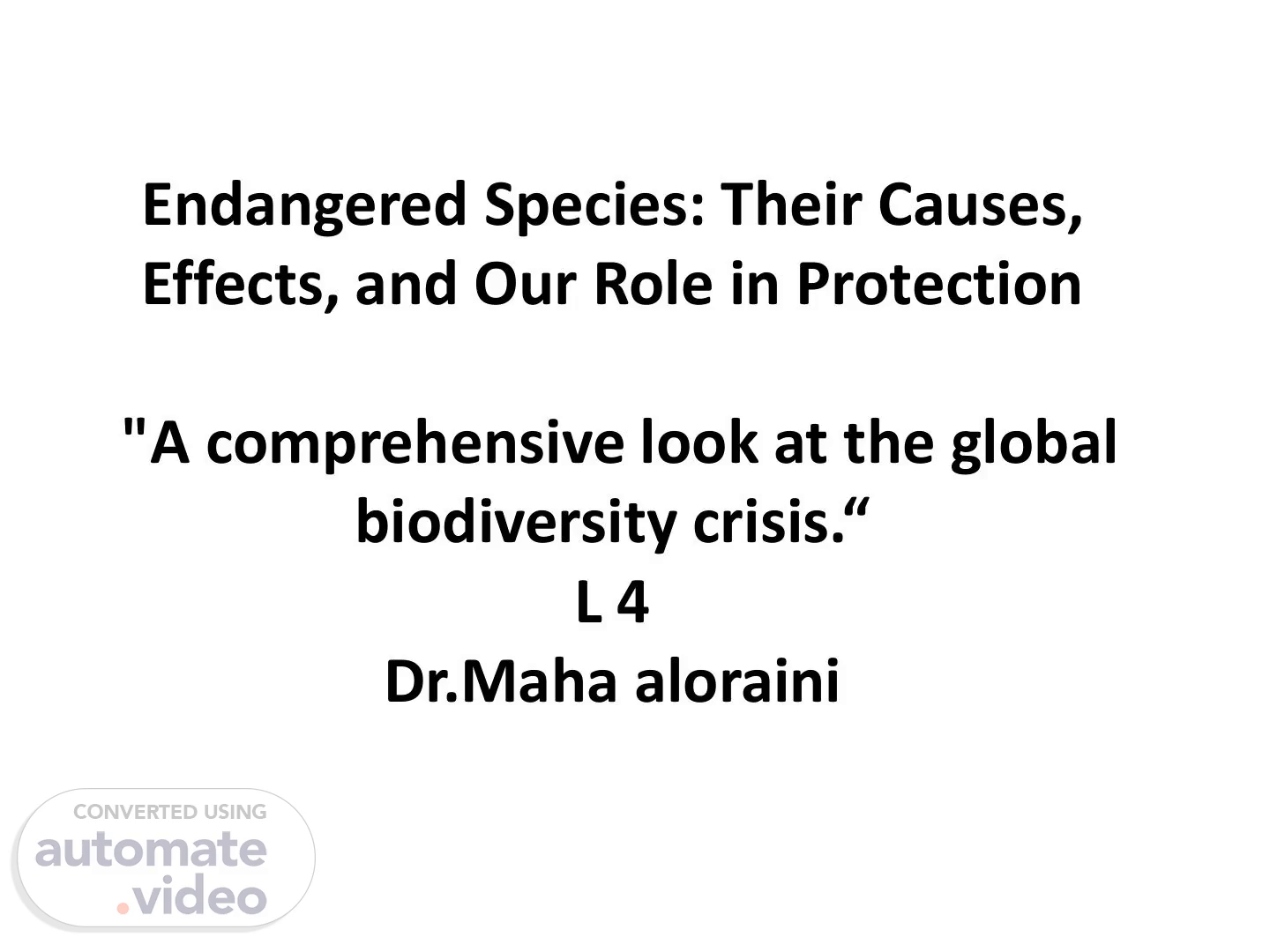Scene 1 (0s)
Endangered Species: Their Causes, Effects, and Our Role in Protection "A comprehensive look at the global biodiversity crisis.“ L 4 Dr.Maha aloraini.
Scene 2 (10s)
Definition of Endangered Species • Living organisms (plants and animals) that face an imminent risk of complete disappearance from planet Earth. • These species are classified based on specific scientific criteria by organizations like the International Union for Conservation of Nature (IUCN), which places them on a "Red List" indicating the severity of their status What Are Endangered Species?.
Scene 3 (27s)
General Introduction Biodiversity: The Foundation of Our Stability • Biodiversity is the complex web of life that includes all living organisms on Earth. It is essential for the stability of ecosystems and provides vital services like water purification and crop pollination. • This web is currently facing unprecedented threats due to human activities, putting millions of species at risk of extinction..
Scene 4 (45s)
CITES Convention CITES: A Global Treaty to Protect Species • The Convention on International Trade in Endangered Species of Wild Fauna and Flora. It is an international treaty signed in 1973. • Its primary goal is to ensure that international trade in wild animals and plants does not threaten their survival in the wild. It achieves this by regulating trade rather than banning it completely..
Scene 5 (1m 3s)
Goals of CITES Securing the Future of Species Through Regulation • Goal 1: Regulating International Trade: By classifying species into three Appendices based on the degree of threat. • Goal 2: Limiting Over-exploitation: Placing strict restrictions on trade for the most vulnerable species, while allowing trade for other species under specific conditions..
Scene 6 (1m 20s)
Species Loss The Main Causes: 1- Habitat Loss: The single most important cause. 2- Climate Change: Alters environmental conditions faster than species can adapt. 3- Pollution: Causes poisoning and the destruction of ecosystems. 4- Over-exploitation: Includes illegal hunting and trade..
Scene 7 (1m 36s)
The Destruction of Natural Homes for Animals • Deforestation: To expand agricultural land or for logging. • Urban Sprawl: The construction of cities and infrastructure fragments habitats and makes them uninhabitable. • Excessive Agriculture: The use of vast land areas for monoculture reduces biodiversity. Habitat Loss.
Scene 8 (1m 51s)
The Impact of Climate Change New Environmental Challenges • Rising Temperatures: Lead to the conversion of natural habitats into unsuitable environments, forcing species to relocate or die. • Melting Ice: Directly threatens species like polar bears and seals that depend on ice for hunting and breeding. • Disruption of Life Cycles: Migration, breeding, and foraging patterns change due to climate shifts..
Scene 9 (2m 9s)
The Impact of Chemical Use Toxins in Our Environment: • Pesticides: Such as DDT, which caused the thinning of eggshells in birds of prey, leading to a population decline. • Industrial Pollution: Affects water and air quality, harming fish and other marine life. • Accumulation of Toxins in Food Chains: Known as biomagnification, where toxins accumulate in small animals and then transfer in higher concentrations to larger predators..
Scene 10 (2m 29s)
Cultural Use of Species Traditions That Threaten Life • Traditional Medicine: The use of parts of endangered animals like rhino horns and tiger claws, based on beliefs in their medicinal benefits. • Ornaments and Jewelry: The use of ivory from elephants or tortoise shells for making ornaments..
Scene 11 (2m 45s)
Poaching An Illegal Trade Destroying Wildlife • Poaching of Elephants for Ivory: Has led to a significant decline in the African elephant population. • Poaching of Rhinos for Horns: Has caused the extinction of some rhino species and put the remaining ones in great danger..
Scene 12 (2m 59s)
Invasive Species Invaders Threatening Local Ecosystems • Living organisms that are intentionally or accidentally introduced to an environment that is not their native habitat. • Impact: They compete with local species for food and resources, prey on them directly, and transmit diseases, leading to a disruption of the ecological balance and potentially the extinction of native species..
Scene 13 (3m 16s)
Examples of Invasive Species • Rabbits in Australia: Introduced from Europe, they bred in huge numbers, destroying local plants and competing with kangaroos. • Non-native Fish in Lakes: Can eat native fish or alter water quality, harming biodiversity..
Scene 14 (3m 30s)
Species Extinction A Painful Reminder: Species That No Longer Exist • Mammoth: Became extinct thousands of years ago due to climate change and overhunting. • Dodo Bird: Became extinct in the 17th century due to overhunting and habitat destruction by settlers..
